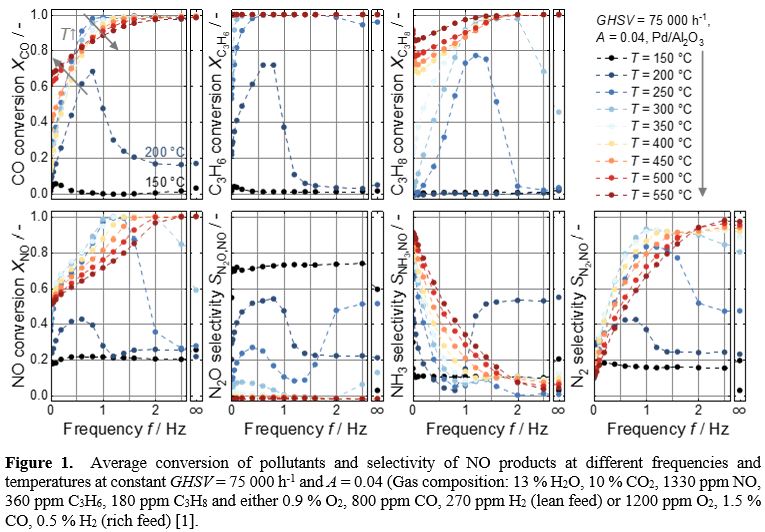Hybrid electric vehicles (HEVs) are known for their impressive fuel efficiency, consuming less fuel than conventional internal combustion engine (ICE) vehicles in urban driving conditions, thereby offering a substantial reduction in CO
2 emissions. However, the frequent starts and stops of the engine in HEVs result in lower exhaust gas temperatures, leading to decreased conversion rates of CO, NOx, and unburned hydrocarbons at the three-way catalyst (TWC) used for aftertreatment. Moreover, the non-selective reduction of NO in the TWC can generate N
2O and NH
3, potent greenhouse gases harmful to both human health and the environment. To address these challenges, so-called dithering has been proposed for the operation of future ICEs. This method involves alternating between rich and lean mixture states instead of maintaining a stoichiometric exhaust gas composition, resulting in increased pollutant conversion at the TWC, especially during cold starts.
To delve deeper into the effects of dithering, a thorough parametric study was conducted on a monolithic 2-wt% Pd/Al2O3 catalyst sample that was tested in a laboratory catalyst testing bench using synthetic exhaust gas. The results, illustrated in Figure 1, demonstrate that at temperatures between 150°C and 350°C, periodic operation through dithering achieves higher pollutant conversions compared to steady-state operation. For instance, at 250°C and a frequency of 1.2Hz, there was an 80% increase in the conversion of NO and C3H8. However, as the temperature increases, the optimal frequency for pollutant conversion shifts to higher values, eventually favoring steady-state operation.
In conclusion, periodic operation through dithering is a promising strategy for enhancing pollutant conversion, especially at low and medium temperatures. This approach could significantly reduce cold-start emissions from gasoline engines, helping to meet stricter emission regulations in the future.
[1] D. Hodonj, M. Borchers, L. Zeh, G.T. Hoang, S. Tischer, P. Lott, O. Deutschmann, Appl. Catal. B: Environ. 345 (2024) 123657

